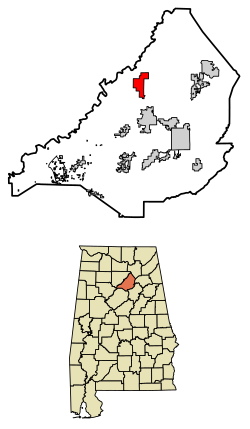Blountsville, Alabama | |
|---|---|
 Main Street (U.S. Route 231) | |
 Location of Blountsville in Blount County, Alabama. | |
| Coordinates: 34°04′53″N86°35′12″W / 34.08139°N 86.58667°W [1] | |
| Country | United States |
| State | Alabama |
| County | Blount |
| Government | |
| • Type | Mayor-Council |
| • Mayor | Michael Glass [2] |
| Area | |
• Total | 5.49 sq mi (14.22 km2) |
| • Land | 5.42 sq mi (14.04 km2) |
| • Water | 0.069 sq mi (0.18 km2) |
| Elevation | 764 ft (233 m) |
| Population (2020) | |
• Total | 1,826 |
| • Density | 336.9/sq mi (130.06/km2) |
| Time zone | UTC-6 (Central (CST)) |
| • Summer (DST) | UTC-5 (CDT) |
| ZIP code | 35031 |
| Area codes | 205, 659 |
| FIPS code | 01-07456 |
| GNIS feature ID | 2405280 [1] |
| Website | blountsvilleal |
Blountsville is a town in Blount County, Alabama, United States. As of the 2020 census it had a population of 1,826. [4]
Contents
- History
- Geography
- Government and public safety
- Demographics
- 2020 census
- 2010 census
- Education
- Attractions
- In popular culture
- References
- Further reading
- External links
Blount County was created by the Alabama territorial legislature on February 6, 1818, from land ceded to the federal government by the Creek Nation on August 9, 1814. It was named for Gov. Willie G. Blount of Tennessee, who provided assistance to settlers in Alabama during the Creek War of 1813–14. It lies in the northeastern section of the state, generally known as the mineral region.
